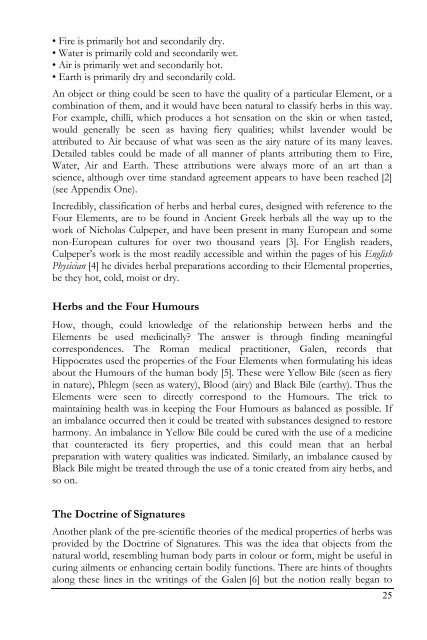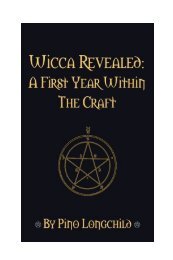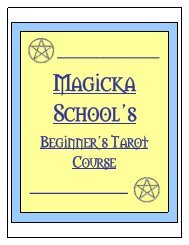A Magickal Herball Compleat.pdf - Magicka School
A Magickal Herball Compleat.pdf - Magicka School
A Magickal Herball Compleat.pdf - Magicka School
You also want an ePaper? Increase the reach of your titles
YUMPU automatically turns print PDFs into web optimized ePapers that Google loves.
• Fire is primarily hot and secondarily dry.<br />
• Water is primarily cold and secondarily wet.<br />
• Air is primarily wet and secondarily hot.<br />
• Earth is primarily dry and secondarily cold.<br />
An object or thing could be seen to have the quality of a particular Element, or a<br />
combination of them, and it would have been natural to classify herbs in this way.<br />
For example, chilli, which produces a hot sensation on the skin or when tasted,<br />
would generally be seen as having fiery qualities; whilst lavender would be<br />
attributed to Air because of what was seen as the airy nature of its many leaves.<br />
Detailed tables could be made of all manner of plants attributing them to Fire,<br />
Water, Air and Earth. These attributions were always more of an art than a<br />
science, although over time standard agreement appears to have been reached [2]<br />
(see Appendix One).<br />
Incredibly, classification of herbs and herbal cures, designed with reference to the<br />
Four Elements, are to be found in Ancient Greek herbals all the way up to the<br />
work of Nicholas Culpeper, and have been present in many European and some<br />
non-European cultures for over two thousand years [3]. For English readers,<br />
Culpeper’s work is the most readily accessible and within the pages of his English<br />
Physician [4] he divides herbal preparations according to their Elemental properties,<br />
be they hot, cold, moist or dry.<br />
Herbs and the Four Humours<br />
How, though, could knowledge of the relationship between herbs and the<br />
Elements be used medicinally? The answer is through finding meaningful<br />
correspondences. The Roman medical practitioner, Galen, records that<br />
Hippocrates used the properties of the Four Elements when formulating his ideas<br />
about the Humours of the human body [5]. These were Yellow Bile (seen as fiery<br />
in nature), Phlegm (seen as watery), Blood (airy) and Black Bile (earthy). Thus the<br />
Elements were seen to directly correspond to the Humours. The trick to<br />
maintaining health was in keeping the Four Humours as balanced as possible. If<br />
an imbalance occurred then it could be treated with substances designed to restore<br />
harmony. An imbalance in Yellow Bile could be cured with the use of a medicine<br />
that counteracted its fiery properties, and this could mean that an herbal<br />
preparation with watery qualities was indicated. Similarly, an imbalance caused by<br />
Black Bile might be treated through the use of a tonic created from airy herbs, and<br />
so on.<br />
The Doctrine of Signatures<br />
Another plank of the pre-scientific theories of the medical properties of herbs was<br />
provided by the Doctrine of Signatures. This was the idea that objects from the<br />
natural world, resembling human body parts in colour or form, might be useful in<br />
curing ailments or enhancing certain bodily functions. There are hints of thoughts<br />
along these lines in the writings of the Galen [6] but the notion really began to<br />
25




